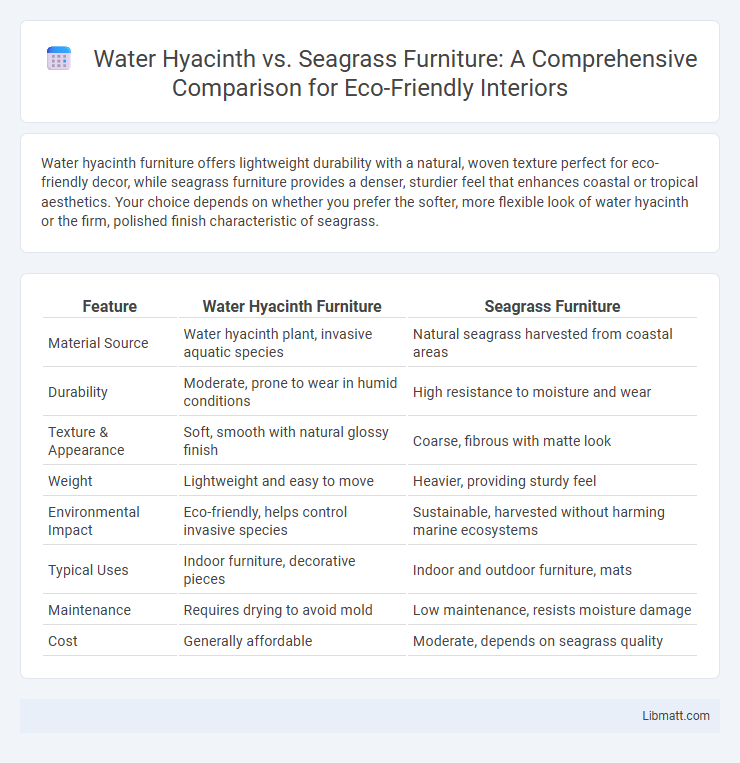Water hyacinth furniture offers lightweight durability with a natural, woven texture perfect for eco-friendly decor, while seagrass furniture provides a denser, sturdier feel that enhances coastal or tropical aesthetics. Your choice depends on whether you prefer the softer, more flexible look of water hyacinth or the firm, polished finish characteristic of seagrass.
Table of Comparison
| Feature | Water Hyacinth Furniture | Seagrass Furniture |
|---|---|---|
| Material Source | Water hyacinth plant, invasive aquatic species | Natural seagrass harvested from coastal areas |
| Durability | Moderate, prone to wear in humid conditions | High resistance to moisture and wear |
| Texture & Appearance | Soft, smooth with natural glossy finish | Coarse, fibrous with matte look |
| Weight | Lightweight and easy to move | Heavier, providing sturdy feel |
| Environmental Impact | Eco-friendly, helps control invasive species | Sustainable, harvested without harming marine ecosystems |
| Typical Uses | Indoor furniture, decorative pieces | Indoor and outdoor furniture, mats |
| Maintenance | Requires drying to avoid mold | Low maintenance, resists moisture damage |
| Cost | Generally affordable | Moderate, depends on seagrass quality |
Introduction to Water Hyacinth and Seagrass Furniture
Water hyacinth furniture is crafted from the fast-growing aquatic plant known for its sturdy, lightweight fibers that offer natural durability and eco-friendly appeal. Seagrass furniture utilizes woven fibers derived from maritime plants, providing a resilient texture and sustainable alternative for interior decor. Both materials support environmental sustainability by using renewable, biodegradable resources while adding unique, organic aesthetics to living spaces.
Material Origins: Water Hyacinth vs Seagrass
Water hyacinth furniture is crafted from fibers derived from the aquatic water hyacinth plant, known for its rapid growth in freshwater environments, making it a highly renewable and eco-friendly resource. Seagrass furniture originates from marine plants found in shallow coastal waters, prized for their durability and natural resistance to moisture and pests. The distinct material origins influence the texture, strength, and sustainability profiles of each furniture type, with water hyacinth offering a soft, woven aesthetic and seagrass delivering robust, long-lasting properties.
Sustainability and Environmental Impact
Water hyacinth furniture utilizes a fast-growing, renewable aquatic plant that absorbs pollutants, making it an eco-friendly choice with a low carbon footprint. Seagrass furniture, crafted from marine grass that stabilizes coastal ecosystems and supports biodiversity, offers durability and biodegradability while promoting ocean health. Your sustainable furniture decision supports natural resource conservation and reduces environmental degradation through biodegradable, renewable materials.
Durability and Longevity Comparison
Water hyacinth furniture, crafted from fast-growing aquatic plants, offers moderate durability but is more susceptible to moisture damage and wear over time. Seagrass furniture boasts higher durability and longevity due to its dense fiber structure, resistance to mold, and natural water-resistant properties. Investing in seagrass pieces ensures prolonged use and sustained aesthetic appeal, especially in humid or outdoor environments.
Aesthetic Appeal: Texture and Color Differences
Water Hyacinth furniture features a tightly woven texture with a natural, light tan hue that offers a rustic and organic aesthetic. Seagrass furniture displays a coarser, more rugged texture with shades ranging from pale green to deep olive, lending a coastal and earthy vibe. The color variations in water hyacinth emphasize warm, golden tones, while seagrass highlights cooler, muted greens, influencing the overall ambiance of interior spaces.
Comfort and Usability Features
Water hyacinth furniture offers natural flexibility and lightweight construction, making it easy to move and comfortable for casual seating. Seagrass furniture boasts a denser weave that provides enhanced durability and firm support, ideal for structured seating and long-term use. Your choice between these materials depends on whether you prioritize softness and portability or robust design and sustained comfort.
Maintenance and Cleaning Requirements
Water hyacinth furniture requires regular dusting and occasional wiping with a damp cloth to prevent mold and maintain its natural look, while seagrass furniture demands gentle cleaning with mild soap and water to avoid damaging its delicate fibers. Both materials benefit from avoiding prolonged exposure to direct sunlight and moisture, but water hyacinth is generally more prone to fraying and mold if not properly cared for. Your choice should consider the cleaning effort you are willing to invest, as seagrass typically offers a more durable and low-maintenance option compared to water hyacinth.
Price Range and Affordability
Water Hyacinth furniture typically ranges from $100 to $500, offering an affordable and eco-friendly option for budget-conscious buyers seeking lightweight, sustainable pieces. Seagrass furniture often falls between $150 and $700, reflecting its durability and intricate weaving techniques, which may demand a higher investment. Your choice depends on balancing cost with longevity, as Water Hyacinth provides budget-friendly charm, while Seagrass offers premium durability at a moderate price premium.
Best Uses and Room Suitability
Water hyacinth furniture excels in casual living areas and sunrooms due to its lightweight, natural texture, making it ideal for creating relaxed, eco-friendly environments. Seagrass furniture offers a sturdier option suitable for dining rooms and offices, valued for its durability and ability to withstand daily use while adding a sophisticated, coastal aesthetic. Both materials thrive in humidity, but seagrass's resilience suits high-traffic indoor spaces better, while water hyacinth enhances informal, decorative settings.
Conclusion: Which Furniture is Best for You?
Choosing between water hyacinth and seagrass furniture depends on your preference for texture, durability, and environmental impact. Water hyacinth furniture offers a softer, woven finish with high resistance to pests and moisture, making it ideal for humid environments, while seagrass furniture provides a sturdier, eco-friendly option with a tighter weave and natural tone suited for minimalist or coastal decor. Evaluate your space's conditions and aesthetic goals to select the furniture that best balances sustainability, comfort, and style.
Water Hyacinth vs Seagrass Furniture Infographic

 libmatt.com
libmatt.com